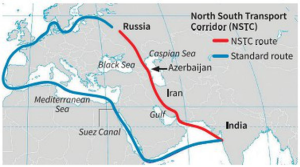Context:
India and Iran plan to step up operationalizing the International North South Trade Corridor (INSTC) in a move to boost trade with Russia.
(Image Credits: The Hindu)
About International North South Trade Corridor:
- The INSTC was initiated in 2000 by Russia, India and Iran, is a multi-modal transportation route linking the Indian Ocean and the Persian Gulf to the Caspian Sea via Iran, and onward to northern Europe via St Petersburg in Russia.
- INSTC consists of sea routes, rail links, and road connections that connect Mumbai in India to Saint Petersburg in Russia, passing through Chabahar.
- Member Countries: It has been ratified by 13 countries namely, Azerbaijan, Belarus, Bulgaria, Armenia, India, Iran, Kazakhstan, Kyrgyzstan, Oman, Russia, Tajikistan, Turkey, and Ukraine.
- The corridor has several branches:
- On the western side of the Caspian Sea, it would link Russia to Iran through Azerbaijan.
- The eastern branch runs along the eastern coast of the Caspian Sea and links the main corridor to different road and rail networks of Central Asian countries such as Turkmenistan and Kazakhstan.
- Benefits:
- Boost to Energy Security: India remains dependent on imports for about 80% of its energy requirements, this corridor would open fresh avenues for energy security.
- Enhanced Trade Connectivity:The INSTC can boost trade between India and Central Asia.
- For Example: INSTC could boost trade to a total of US$ 170 billion from India to Eurasia (60.6 billion in export and 107.4 billion in import).
- Reduce Transit Time: The INSTC is projected to reduce transit time by 40%, shortening it from 45-60 days to 25-30 days.
- Decrease in Freight Cost: Additionally, it is expected to decrease freight costs by 30% in comparison to the Suez Canal route.
News Source: ET
![]() 18 Jul 2023
18 Jul 2023
